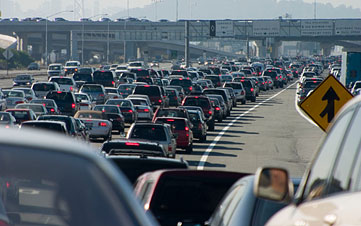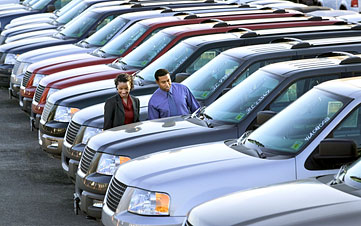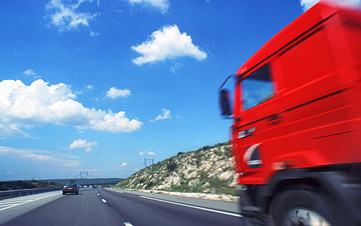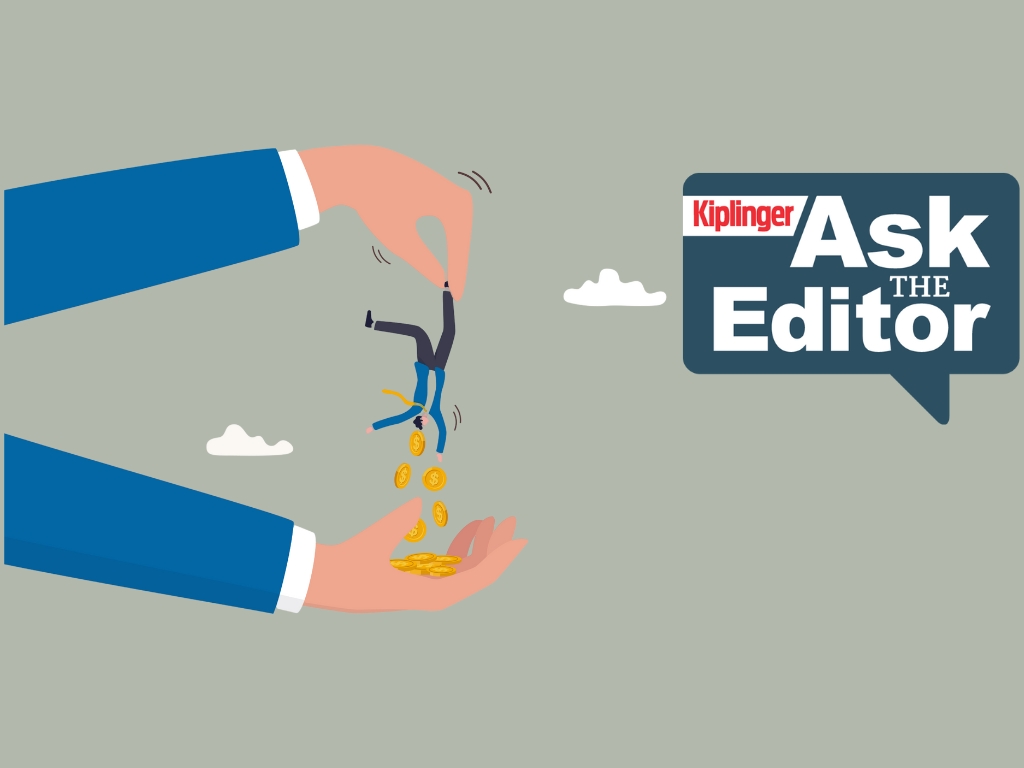12 Ways $5-A-Gallon Gasoline Would Change America
Gasoline prices have been rising.
Gasoline prices have been rising. Paying $4 a gallon (on average) when the heavy driving season begins this summer is not out of the question. What if gas hits $5? An attack on Iran’s nuclear sites or a severe hurricane hitting U.S. refineries could do that.
And though the economy is no longer as dependent on oil as it was 40, 30 or even 20 years ago, sharp energy price hikes still pack a wallop. Gasoline prices reaching and staying at $5 a gallon for three or four months would likely trim already lackluster economic growth. Consumers paying more at the pump would reduce spending on other things. Businesses would likely be more cautious about hiring. We'd feel it across the economy in ways both obvious and subtle.
Here are 12 ways $5-a-gallon gasoline prices would likely impact consumers; businesses; local, state and national government; and the economy.

Crowded Commuter Trains and Buses
In summer 2008, when gasoline prices last peaked, mass transit use across the nation jumped 6.5% from the summer 2007 level. If pump prices hit $5 a gallon this year, even more folks will ditch their daily drives to jam buses and trains.
Higher fuel bills will take a toll on transit budgets, too. Aside from labor, fuel is the biggest expense transit systems face. Nationwide, mass transit systems account for about 783 million gallons of gasoline and diesel use per year..Nationwide, a 20% to 30% hike in prices would add $3.3 billion to $3.5 billion to the cost of public transit operations, in many cases forcing them to jack up passenger fares.
Megabus, BoltBus and other transit lines that run between major cities will book up fast, in part because ticket prices aren't likely to rise much with the increase in gasoline costs. In 2006 and again in 2008, ridership rose enough for companies to offset the extra expense without raising fares. But since these bus lines charge based on popularity of travel times and dates, as well as how far in advance tickets are purchased, riders will have to either firm up their plans early or be flexible about traveling at off-hours to get the cheapest seats.

More Potholes, Bigger Traffic Jams
As gas prices rise, motorists drive fewer miles and buy less fuel. Fewer gallons of gas sold mean lower tax revenues for states and the federal government to spend on maintaining roads, bridges and highways.
At $5 a gallon, drivers are sure to rein in their excursions even more.
More-fuel-efficient cars are already drying up tax revenues. In 2010, total federal taxes collected were $27.4 billion, compared to $30.5 billion in 2006 (adjusted for inflation). Over the same period, state fuel-tax revenues collected by New York, the state with the highest gas tax rate, fell by more than $100 million.
Don't be surprised if states increasingly turn to alternative means such as additional reliance on toll roads or increases in vehicle titling fees. Or it could mean simply raising the fuel tax rates, making gasoline even pricier.

Fewer Car Sales? Probably Not
Conventional wisdom has it that rising gas prices equal falling sales. The logic: Consumers are reluctant to lay out the cash for a new set of wheels when the car will cost more to operate. In some cases, the higher fuel price means car owners can't swing the price of a new ride.
Yet, there are good reasons to believe that Americans will buy around a million more vehicles in 2012 than they did in 2011, despite the higher costs.
The economy is stronger than it was in 2008, when high gasoline prices helped chop about 3 million from 2007 sales. The punk economy then turned out to be the early stages of a severe recession. Now it's in recovery mode, and consumers are becoming increasingly optimistic about their prospects.
Consumers aren't as fazed by sharp spikes in gas prices as before. Automakers have bulked up their inventories of smaller, gas-sipping models and are delivering a slew of attractive new compacts with interior amenities that mimic bigger, more expensive cars while getting upwards of 40 miles per gallon on the highway. Hybrids will see another surge in demand, too, though they'll still be just a small percentage of total purchases.

A Boom in GPS Systems
More car companies, cabdrivers, restaurant delivery services and others that make multiple short trips will turn to satellite-based navigation systems to make sure drivers don't go even a block beyond where they need to. More companies are also likely to install tracking systems such as Geomoto and NexTraq to check on drivers, making sure they're not wasting fuel by idling vehicles or making unscheduled stops.
Similarly, consumers will try harder to stretch their gasoline dollars further. More than two-thirds of consumers say they'll try harder to combine errands.

Shorter, Cheaper, Nearby Vacations
Americans won't give up their summer holidays just because they'll cost more. They will, however, choose destinations that are closer. Many of those who usually fly cross-country will choose to drive to someplace a bit closer to home. Others who typically drive a day or two to reach their chosen vacation spot may opt to stick within a one-day radius of home. And still others will try a "staycation."
Parks can look forward to strong years, with more visitors opting to lounge by the lake or hike, rather than shelling out big bucks to fly across the country to tour Boston or hit theme parks. Camping out will get a popularity boost. Casual and family-style restaurants are likely to see business drop off a bit. Families on the road, or simply seeking a night off from cooking, will be more inclined to pass up Denny's, Applebee's and similar restaurants in favor of fast food. But white-tablecloth restaurants shouldn't feel much impact. Most of their diners are well-heeled enough to pay more at the pump and still have filet at their favorite dining spot.

Pinched Municipal Services
Think your pickup truck is a gas-guzzler? Imagine filling a 14-ton fire engine -- or a small fleet of V-8-powered Ford Police Interceptors.
The average midsize city police department already spends an average of $100,000 a month to fuel its patrol cars. So a 25% bump in pump prices that lasts about three months will cost the city taxpayers an additional $75,000 this year. Another big fuel user: school buses. The Des Moines, Iowa, school system, for example, forks over $9 million a year to cover 1.5 million miles a year. A $1-a-gallon jump in the price of diesel fuel would raise the cost of providing those services by about $50,000 a month.
Given how stretched most state and local budgets already are, the extra drain would be painful indeed. As a result, some cities and towns are contemplating charging fees when fire departments are called out. Others may be forced to raise taxes.

Pricier Pineapples and Costlier Milk
Roughly one dime of every dollar spent on food in the U.S. pays for transportation and fuel. So, in theory, a 25% increase in the price of fuel would add about 2.5% to the average family's monthly bill for meals. In fact, the impact is likely to vary a great deal, because the amount of fuel used in the production, processing and transportation of foods differs markedly from one product to another, and because the cost of fuel has a more immediate impact in some cases than in others.
Milk, for example, goes from cow to supermarket quickly, so the extra cost for trucking it may show up quickly, raising prices by a dime a gallon or so. And the price of tropical fruits and vegetables, which must be transported a long way, may tick higher.
In contrast, the price of beef, pork and eggs may not be affected much, at least this year. But much of that is because their prices already experienced steep hikes late in 2011.

A Bigger Bill for Uncle Sam
As the single largest consumer of oil in the world, the U.S. military will certainly feel pain at the pump. In 2011, the various branches of the Defense Department gulped up 120 million barrels of fuel. Jet fuel alone accounts for 70% of the Pentagon's fuel use. Think of this: An F/A-18 fighter burns $11,000 of fuel every hour in flight. Jets aren't the only military craft that get lousy mileage. An M1 Abrams tank takes about 1.3 gallons of fuel per mile.
All told, the Defense Department spent a total of about $17.3 billion on fuel last year. While that's a mere 2.6% of the U.S. military's total budget, a potential 25% increase in the price of oil-based fuels for a period of several months would tack an additional $3 billion to Uncle Sam's tab for keeping the military rolling.

A More Generous IRS
Folks who drive their vehicles for business will be able to claim higher deductions. Odds are that the Internal Revenue Service would raise the current 55.5¢-a-mile standard mileage allowance to account for the higher cost of gas. Best bet is an increase of 10¢-12¢ a mile if the national average price of regular gasoline climbs to $5 a gallon and stays there for at least a few months. There's precedent for a midyear allowance hike, too. When prices spiked in 2008 and 2011, IRS increased the mileage allowance for the last six months of each year.

Another Woe for the Post Office
Higher gasoline prices will slam the already beleaguered U.S. Postal Service. An increase of a single penny in pump prices costs USPS an additional $7 million a year. A jump of a buck a gallon, even if only for a three- or four-month period, would pour more red ink into the $16-billion flood it's expected to face this year.
Unlike the Post Office, private delivery services, such as FedEx and UPS, can and do jack up the prices they charge customers when fuel costs soar. Both companies already impose a fuel surcharge, adjusted once a month, based on the average daily spot price for diesel and jet fuel prices two months earlier. For example, in April UPS tacked 8% onto bills for ground transportation and 14% for air transportation.

Rejiggered Household Budgets
If gasoline prices top $5 a gallon, the average U.S. household will wind up spending an extra $90 a month at the pump, a 39% increase from 2011. For most, that money will have to come from cutbacks in spending someplace else.
Each household will, of course, make different choices about where to cut back. But for all households as an aggregate, spending on some products isn't likely to change: health care, utilities, tobacco, and baked goods and sweets.
Here's what would get trimmed: $20 a month less on eating out. $5 a month less for alcohol. Apparel and shoes, down $20 a month. $15 less for movies, DVDs and other entertainment. Pets, toys and hobbies will get $10 less a month. About $10 a month will be saved by including less poultry, red meat and fish in meals, and $5 less a month will be spent on dairy products. And more kids, apparently, will have to clean their own rooms -- spending on housekeeping services and supplies will be shaved by $5 a month.

More Variation in Pump Prices State to State
If the national average price for gasoline at the pump does reach $5 a gallon this summer, it won't mean everyone is forking out a fiver for every gallon they pump.
In fact, the difference between what consumers in some states may pay and what consumers in others shell out would easily top $1 a gallon. Some of the differences reflect transportation costs: That's why, for example, the country’s highest-priced gasoline is in Alaska and Hawaii. Both are far from refineries and require costly transportation by ship. In contrast, gas stations in Wyoming, Oklahoma and Utah, for example, benefit from having refineries nearby.But state taxes also account for a big chunk of the price differentials. New York, for example, with the highest gasoline taxes in the nation, tacks a whopping 49¢ per gallon on to motorists' bills. Calif., Connecticut and Illinois also have high gasoline taxes. In contrast, Arkansas, New Jersey and Missouri collect far less at the pump, between 8¢ and 17.3¢.

Profit and prosper with the best of Kiplinger's advice on investing, taxes, retirement, personal finance and much more. Delivered daily. Enter your email in the box and click Sign Me Up.
-
 Top Tech Gifts to Grab at Walmart Before Christmas
Top Tech Gifts to Grab at Walmart Before ChristmasBig savings on Apple, Bose, HP, Vizio and more while there's still time to shop.
-
 AI Appliances Aren’t Exciting Buyers…Yet
AI Appliances Aren’t Exciting Buyers…YetThe Kiplinger Letter Artificial intelligence is being embedded into all sorts of appliances. Now sellers need to get customers to care about AI-powered laundry.
-
 Ask the Editor: IRAs, 401(k)s and RMDs
Ask the Editor: IRAs, 401(k)s and RMDsAsk the Editor In this week's Ask the Editor Q&A, Joy Taylor answers questions on IRAs, 401(k)s and required minimum distributions
-
 What to Do With Your Tax Refund: 6 Ways to Bring Growth
What to Do With Your Tax Refund: 6 Ways to Bring GrowthUse your 2024 tax refund to boost short-term or long-term financial goals by putting it in one of these six places.
-
 What Does Medicare Not Cover? Eight Things You Should Know
What Does Medicare Not Cover? Eight Things You Should KnowMedicare Part A and Part B leave gaps in your healthcare coverage. But Medicare Advantage has problems, too.
-
 15 Reasons You'll Regret an RV in Retirement
15 Reasons You'll Regret an RV in RetirementMaking Your Money Last Here's why you might regret an RV in retirement. RV-savvy retirees talk about the downsides of spending retirement in a motorhome, travel trailer, fifth wheel, or other recreational vehicle.
-
 The 24 Cheapest Places To Retire in the US
The 24 Cheapest Places To Retire in the USWhen you're trying to balance a fixed income with an enjoyable retirement, the cost of living is a crucial factor to consider. Is your city the best?
-
 The Six Best Places to Retire in New England
The Six Best Places to Retire in New Englandplaces to live Thinking about a move to New England for retirement? Here are the best places to land for quality of life, affordability and other criteria.
-
 The 10 Cheapest Countries to Visit
The 10 Cheapest Countries to VisitWe find the 10 cheapest countries to visit around the world. Forget inflation and set your sights on your next vacation.
-
 15 Ways to Prepare Your Home for Winter
15 Ways to Prepare Your Home for Winterhome There are many ways to prepare your home for winter, which will help keep you safe and warm and save on housing and utility costs.
-
 Six Steps to Get Lower Car Insurance Rates
Six Steps to Get Lower Car Insurance Ratesinsurance Shopping around for auto insurance may not be your idea of fun, but comparing prices for a new policy every few years — or even more often — can pay off big.
